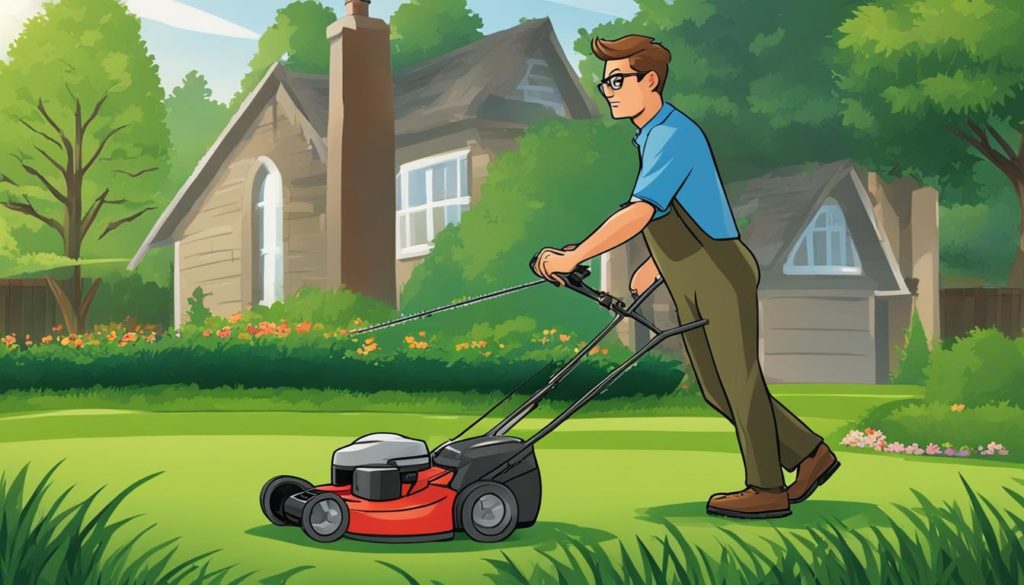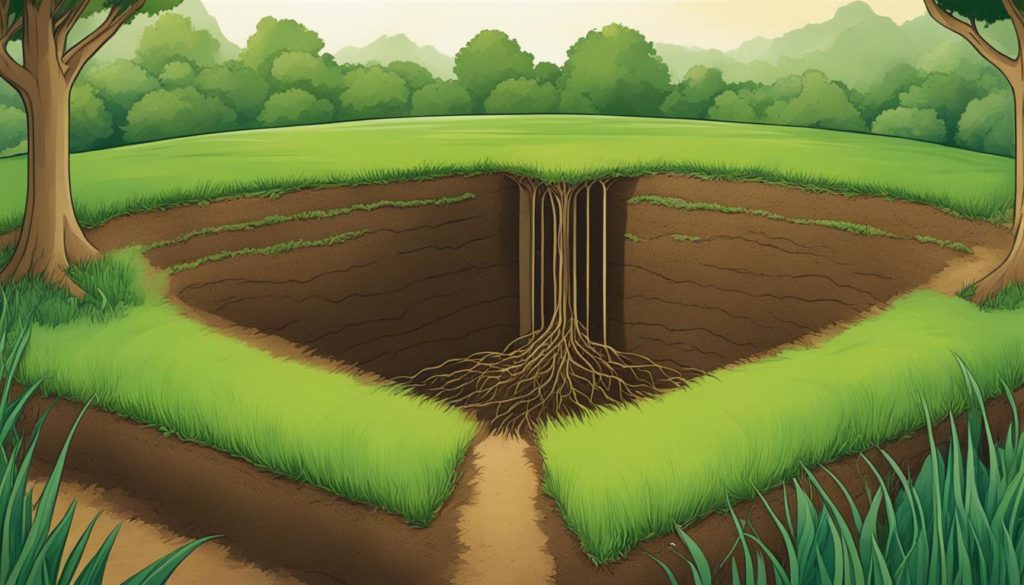Welcome to our comprehensive guide on the importance of lawn care. In this article, we will explore the benefits of properly caring for your lawn and how it can transform your outdoor space. Whether you are a seasoned gardener or new to lawn care, understanding the significance of maintaining your lawn will help you achieve a lush and vibrant landscape that enhances the overall beauty of your home.
Key Takeaways:
- Proper lawn care boosts curb appeal and contributes to a healthy outdoor space
- Understanding your grass type and soil condition is essential for tailoring your care routine
- Mastering mowing techniques, proper watering, and fertilization promotes optimal growth
- Preventing weeds, pests, and diseases ensures a healthy and thriving lawn
- Aeration, mulching, and seasonal care are key practices for maintaining a beautiful lawn
Understand Your Grass Type and Soil Condition
Before you embark on your lawn care journey, it’s important to understand the type of grass in your lawn and the condition of your soil. Different grass species have different needs and requirements, and tailoring your care routine to your specific grass type will ensure optimal results.
To identify your grass type, you can refer to a local turfgrass expert, use online resources, or consult with a professional lawn care service. Once you know your grass type, you can then determine the ideal mowing height, watering schedule, and fertilization needs for your lawn.
In addition to understanding your grass type, assessing your soil condition is equally crucial. Testing your soil for pH levels, nutrient content, and compaction will provide valuable insights that will guide your lawn care practices. By knowing the specific needs of your soil, you can make informed decisions about fertilization, aeration, and other maintenance tasks.
By taking the time to understand your grass type and soil condition, you will gain valuable knowledge that will enable you to implement the most effective lawn care practices. This will not only promote the health and vitality of your lawn, but also save you time and effort in the long run.
| Grass Type | Soil Condition |
|---|---|
| Bermudagrass | Well-drained soil with a pH of 6.0-7.0 |
| Zoysiagrass | Sandy loam soil with a pH of 6.0-7.0 |
| Fescue | Well-drained soil with a pH of 5.8-7.0 |
| St. Augustinegrass | Moist, well-drained soil with a pH of 5.0-8.5 |
Table: Recommended soil conditions for various grass types
Master the Art of Mowing
Mowing your lawn correctly is crucial for its overall health and appearance. By following proper mowing techniques, you can ensure that your lawn stays lush and vibrant throughout the year. Here are some essential lawn mowing tips to help you maintain a beautiful and well-kept lawn:
- Mow at the right height: Adjust your mower’s cutting height to the appropriate level for your grass type. Mowing too low can stress the grass and leave it vulnerable to weeds and diseases, while mowing too high can lead to thatch buildup and a weak root system.
- Avoid scalping the grass: When mowing, avoid cutting more than one-third of the grass blade’s height at a time. Scalping the grass weakens it and makes it more susceptible to damage and dehydration.
- Keep your mower blades sharp: Dull mower blades tear the grass instead of cleanly cutting it, which can result in a ragged appearance and increase the risk of diseases. Sharpen your mower blades regularly to ensure a clean cut.
- Vary your mowing pattern: Mowing in the same direction every time can cause soil compaction and create ruts in the lawn. Change your mowing pattern each time you mow to promote even growth and prevent damage to the grass.
By following these mowing tips, you can maintain a healthy and attractive lawn throughout the year. Remember, a well-maintained lawn not only enhances the overall beauty of your home but also provides a comfortable outdoor space for you and your family to enjoy.
Mowing Height Recommendations for Common Grass Types:
| Grass Type | Mowing Height |
|---|---|
| Bermuda Grass | 0.5 to 1.5 inches |
| Zoysia Grass | 0.5 to 2 inches |
| Fescue Grass | 2 to 3.5 inches |
| Kentucky Bluegrass | 2 to 3.5 inches |
These mowing height recommendations are general guidelines, and it’s important to check specific recommendations for your grass type. Additionally, adjusting the mowing height based on weather conditions and seasonal changes can help maintain optimal grass health.
Remember:
“Proper mowing is one of the fundamental practices of lawn care. By mowing at the right height and following good mowing techniques, you can achieve a professional-looking lawn that will be the envy of your neighbors.”
With these lawn mowing tips in mind, you can take pride in your well-manicured lawn and enjoy its beauty all year long.

Irrigate Intelligently
Proper watering is essential for maintaining a healthy lawn. It’s important to water deeply and infrequently, depending on factors such as weather and soil type. Utilizing a rain gauge can help monitor natural rainfall and adjust your irrigation schedule accordingly.
One of the key aspects of intelligent irrigation is understanding how much water your lawn needs. Different grass types have different water requirements. For example, cool-season grasses like Kentucky bluegrass and tall fescue need around 1 to 1.5 inches of water per week, while warm-season grasses like Bermuda grass and Zoysia grass require around 0.5 to 1 inch of water per week. By knowing the specific needs of your grass, you can water efficiently and prevent overwatering or underwatering.
Another important factor to consider is the time of day you water your lawn. Watering in the early morning is generally the best time, as it allows the grass to dry before evening and minimizes the risk of disease. Watering during the hottest part of the day can lead to water loss through evaporation, while watering in the evening can promote fungal growth. Additionally, be mindful of local regulations regarding watering restrictions to conserve water resources and promote sustainability.
| Watering Technique | Description |
|---|---|
| Deep Watering | Watering deeply allows moisture to penetrate the soil, encouraging deep root growth and making your lawn more resilient to drought. |
| Infrequent Watering | Watering infrequently, but deeply, encourages grass roots to grow deeper in search of moisture, creating a stronger and healthier lawn. |
| Avoid Overwatering | Overwatering can lead to shallow root growth, nutrient leaching, and increased susceptibility to weeds and diseases. Be mindful of not exceeding the water needs of your lawn. |
| Utilize Rain Gauges | Installing rain gauges in your lawn can help you track rainfall and determine when additional watering is necessary. |
Proper irrigation is crucial for maintaining a healthy lawn. By watering deeply and infrequently, understanding your grass’s specific water needs, and adhering to recommended watering times, you can keep your lawn lush and vibrant while conserving water resources.
Fertilize for Optimal Growth
Fertilizing your lawn is a key aspect of lawn care that promotes optimal growth and maintains its overall health and appearance. By following the principles of nutrient stewardship and adjusting soil pH, you can ensure that your lawn receives the proper nourishment it needs to thrive.
Table: Nutrient Stewardship Guidelines
| Principle | Description |
|---|---|
| Right Source | Choose fertilizers with the appropriate blend of macro and micronutrients for your grass type. |
| Right Rate | Apply fertilizers at the recommended rates to avoid over or under feeding your lawn. |
| Right Time | Apply fertilizers during the active growth periods of your grass to maximize nutrient uptake. |
| Right Place | Distribute the fertilizer evenly across your lawn to prevent uneven growth and potential burn spots. |
Additionally, conducting a soil pH test is essential for understanding the acidity or alkalinity of your soil. Based on the test results, you can make the necessary adjustments to optimize nutrient availability. Most grasses prefer a slightly acidic soil pH between 6 to 7, but it’s important to consult with a lawn care professional or utilize a soil testing kit for accurate results.
Lawn Care Tips for Fertilization:
- Follow the recommended fertilization schedule for your specific grass type.
- Avoid over-fertilization, as it can lead to excessive growth and weaken the grass.
- Water your lawn thoroughly after fertilizing to ensure proper absorption of nutrients.
- Consider using slow-release fertilizers for a more controlled and long-lasting nutrient release.
- Regularly monitor your lawn’s appearance and make adjustments to your fertilization routine as needed.
By implementing proper fertilization techniques and adhering to nutrient stewardship guidelines, you can provide your lawn with the essential nutrients it requires for lush, vibrant growth. Remember to always consider the specific needs of your grass type and soil condition to achieve optimal results.
Win the Battle Against Weeds, Pests, and Diseases
Weeds, pests, and diseases can quickly damage your lawn if left untreated. Implementing preventive measures, using post-emergent herbicides, and monitoring for signs of disease are effective strategies for maintaining a healthy lawn.
When it comes to weed prevention, regular maintenance practices such as proper mowing, watering, and fertilization can go a long way. By keeping your lawn healthy and dense, you create less opportunity for weeds to take over. Additionally, applying pre-emergent herbicides can help prevent weed seeds from germinating and taking root.
Pest control is another crucial aspect of lawn care. Common lawn pests such as grubs, ants, and fleas can wreak havoc on your grass. Applying targeted insecticides and employing natural pest control methods can help keep these unwanted visitors at bay.
Disease management is also essential for maintaining a thriving lawn. Common lawn diseases such as brown patch, dollar spot, and powdery mildew can cause significant damage if not addressed promptly. Monitoring your lawn for signs of disease, practicing proper watering techniques, and applying appropriate fungicides can help prevent and manage lawn diseases effectively.
By taking proactive steps to prevent weeds, control pests, and manage diseases, you can ensure that your lawn remains healthy, vibrant, and lush throughout the year.

The Benefits of Aeration and Thatch Removal
Proper lawn care goes beyond mowing and watering. Aeration and dethatching are essential practices that can greatly improve the health and appearance of your lawn. Let’s explore the benefits of these techniques and how they contribute to a lush and vibrant outdoor space.
What is Lawn Aeration?
Lawn aeration is the process of creating small holes in the soil, allowing oxygen, water, and nutrients to penetrate deep into the grassroots. This promotes better nutrient absorption and root growth, leading to a stronger and healthier lawn. Additionally, aeration helps to alleviate soil compaction, which can hinder the movement of air, water, and nutrients.
The Benefits of Aeration
- Promotes nutrient absorption and oxygen circulation in the soil
- Reduces soil compaction and encourages a strong root system
- Controls thatch buildup, preventing it from suffocating the grass
- Improves water infiltration and reduces runoff
- Supports over-seeding and new grass growth

Lawn aeration should be performed once or twice a year, depending on the condition of your lawn. It is particularly beneficial for lawns with clay or compacted soil, areas with heavy foot traffic, and lawns that receive excessive thatch buildup. Consult a lawn care professional or use a manual or mechanical aerator to ensure the process is carried out effectively.
The Importance of Thatch Removal
Thatch is a layer of dead grass, roots, and debris that accumulates between the turf and the soil surface. Excessive thatch can create a barrier, preventing air, water, and nutrients from reaching the grassroots. It can also harbor pests and diseases, leading to a weakened and unhealthy lawn.
Methods for Thatch Removal
Dethatching can be done manually using a thatch rake or mechanically using a power rake or vertical mower. These tools remove the layer of thatch, allowing the grass to thrive. However, it is important to strike a balance as removing too much thatch can damage the lawn. Aim to keep the thatch layer at around ½ inch or less for optimal lawn health.
In summary, aeration and dethatching are vital components of a comprehensive lawn care routine. By improving soil health, nutrient absorption, and airflow, these practices contribute to a greener, healthier, and more resilient lawn. Incorporate regular aeration and dethatching into your lawn care schedule to reap the full benefits and enjoy a lush, vibrant outdoor space.
Utilize Lawn Care Practices
When it comes to maintaining a healthy and vibrant lawn, it’s important to consider organic lawn care practices. By adopting eco-friendly methods, you not only promote the well-being of your lawn but also contribute to environmental sustainability. Two key practices to incorporate into your lawn care routine are grass cycling and the use of natural fertilizers.
Grass Cycling
Grass cycling involves leaving grass clippings on your lawn after mowing instead of bagging and disposing of them. As the clippings decompose, they release essential nutrients back into the soil, acting as a natural fertilizer. This process not only reduces the need for additional fertilization but also enhances soil health and promotes stronger root development.
Grass cycling offers several benefits, including improved moisture retention, weed suppression, and reduced water usage. The clippings act as a protective mulch layer, helping to keep the soil moist and reducing the need for frequent watering. Additionally, the clippings create a barrier that inhibits weed growth, minimizing the need for herbicides.
Natural Fertilizers
By opting for natural fertilizers, you can nourish your lawn while minimizing harm to the environment. Organic fertilizers, such as compost or manure-based blends, provide a slow-release source of nutrients, ensuring a steady supply for your grass without the risk of chemical runoff. These natural alternatives not only improve soil fertility but also support beneficial microbial activity, contributing to a healthier ecosystem within your lawn.
When selecting a natural fertilizer, consider the specific needs of your lawn and follow the recommended application rates. Adjusting the timing and frequency of fertilizer application based on grass growth and local climate conditions can further enhance the effectiveness of these organic products.
By utilizing lawn care practices that prioritize sustainability, you can maintain a lush and healthy lawn while minimizing your impact on the environment. Grass cycling and the use of natural fertilizers are just two examples of how you can embrace organic lawn care methods and contribute to a greener future.
| Aspect | Organic Fertilizers | Synthetic Fertilizers |
|---|---|---|
| Source | Natural ingredients, such as compost, manure, or plant-based materials | Chemically synthesized compounds |
| Nutrient Release | Slow-release over time | Immediate release |
| Soil Health | Improves soil structure and fosters beneficial microbial activity | May contribute to nutrient imbalances and environmental pollution |
| Environmental Impact | Minimal risk of chemical runoff and water pollution | Potential for leaching into waterways and harm to ecosystems |
| Sustainability | Promotes a greener and more sustainable approach to lawn care | May contribute to environmental degradation and dependence on non-renewable resources |
The Benefits of Mulching
Mulching your lawn offers numerous benefits, making it an essential practice for maintaining a healthy and vibrant outdoor space. Mulch is a protective layer of organic or inorganic material that is spread over the soil surface, providing several advantages for your lawn’s overall health and appearance.
1. Weed Control
Mulching is highly effective in suppressing the growth of weeds, helping to keep your lawn free from unwanted plants. The layer of mulch acts as a physical barrier, preventing weed seeds from receiving adequate sunlight to germinate. Additionally, organic mulches can release natural compounds that inhibit weed growth, reducing the need for manual weeding or the use of chemical herbicides.
2. Water Conservation
Applying mulch to your lawn helps conserve water by reducing evaporation from the soil surface. The layer of mulch acts as a protective barrier, preventing water loss and maintaining soil moisture levels. This is especially beneficial during hot and dry periods when water scarcity is a concern. By conserving water, you can also save on irrigation expenses while promoting the sustainability of your lawn care practices.
3. Improved Soil Fertility
Mulch contributes to the improvement of soil fertility over time. As organic mulches decompose, they release valuable nutrients into the soil, enriching it and promoting the growth of healthy grass. This natural fertilization process reduces the need for synthetic fertilizers, making mulching a sustainable and environmentally friendly lawn care practice.
By incorporating mulching into your lawn care routine, you can enjoy a weed-free, water-efficient, and fertile lawn. Remember to choose the appropriate type of mulch based on your lawn’s needs and preferences, and apply it regularly for optimal results.
| Benefits of Mulching |
|---|
| Weed Control |
| Water Conservation |
| Improved Soil Fertility |
Don’t Forget about the Importance of Seasonal Lawn Care
Proper lawn care is a year-round commitment. To maintain a healthy and vibrant lawn, it’s crucial to adjust your lawn care practices according to the changing seasons. By understanding the unique requirements of each season, you can ensure that your lawn receives the necessary care and attention it needs to thrive.
Here are some essential lawn care tips for each season:
Spring:
- Perform a thorough spring cleaning by removing debris and dead leaves.
- Aerate the soil to improve nutrient absorption and promote healthy root growth.
- Overseed bare patches to encourage new grass growth.
Summer:
- Mow your lawn at a slightly higher height to promote shade and prevent weed growth.
- Water deeply and infrequently, preferably in the early morning or late evening to minimize evaporation.
- Monitor for pests and diseases and take appropriate action if necessary.
Fall:
- Rake and remove fallen leaves to prevent suffocation and disease.
- Fertilize your lawn with a slow-release fertilizer to strengthen the grass before winter.
- Aerate the soil to alleviate compaction and improve nutrient absorption.
Winter:
- Avoid walking on frozen grass to prevent compaction.
- Clear snow and ice from your lawn to prevent damage.
- Maintain a consistent watering schedule to prevent dehydration.
By following these seasonal lawn care tips, you can keep your lawn in optimal condition throughout the year. Remember to adjust your lawn care routine based on the specific needs of your grass type and soil condition. With proper care and attention, you can enjoy a lush and healthy lawn that enhances the beauty of your outdoor space.
The Amazing Benefits of Aeration
Aeration is a transformative technique that can significantly improve the health and appearance of your lawn. By breaking up compacted soil, aeration boosts nutrient absorption, improves oxygen circulation, reduces soil compaction, controls thatch buildup, and supports overseeding and new growth.
One of the key benefits of aeration is enhanced nutrient absorption. When soil becomes compacted, nutrients struggle to penetrate and reach the grass roots. By creating small holes in the soil through aeration, nutrients can easily reach the roots, promoting healthy growth and vibrant green color. This nutrient absorption leads to a stronger and more resilient lawn, better equipped to withstand environmental stressors and disease.
In addition to nutrient absorption, aeration also improves oxygen circulation within the soil. Oxygen is vital for the root development and overall health of your lawn. Compacted soil restricts the flow of oxygen, depriving the roots of this essential element. Aeration allows oxygen to reach the roots, promoting deeper root growth and ensuring a healthier and more robust lawn.
“Aeration is a game-changer for maintaining a healthy lawn. By improving nutrient absorption and oxygen circulation, it revitalizes the soil, resulting in a lush and vibrant lawn.” – Lawn Care Expert
Furthermore, aeration reduces soil compaction, which can hinder the growth of your grass. Heavy foot traffic and the natural settling of soil can lead to compaction over time. Compacted soil prevents roots from accessing the necessary nutrients, water, and air. By aerating the soil, you alleviate compaction, allowing roots to expand and develop more robustly. This results in a healthier and more resilient lawn that is better able to tolerate drought, heat, and other unfavorable conditions.
Finally, aeration is an effective method for controlling thatch buildup. Thatch is a layer of dead grass, roots, and debris that accumulates on the surface of the soil. Excessive thatch prevents water, air, and nutrients from reaching the soil, leading to poor lawn health. Aeration helps break up thatch, allowing it to decompose naturally and improving the overall health of your lawn.
Enhance Your Lawn with Aeration
In summary, aeration offers numerous benefits that contribute to the overall health and appearance of your lawn. From improving nutrient absorption and oxygen circulation to reducing soil compaction and controlling thatch buildup, aeration is a vital practice for maintaining a lush and vibrant lawn. By incorporating aeration into your lawn care routine, you can unlock the full potential of your lawn and enjoy a beautiful outdoor space year-round.
Conclusion
Proper lawn care is vital for achieving a healthy and beautiful lawn. By understanding your grass type, implementing effective mowing, watering, and fertilization techniques, and addressing common lawn issues, you can unlock the full potential of your lawn.
Start by identifying your grass type and soil condition to tailor your care routine accordingly. Master the art of mowing by adjusting the mowing height, avoiding scalping, and varying your mowing pattern. Irrigate intelligently by watering deeply and infrequently, based on weather and soil type.
Fertilize your lawn using the 4Rs of nutrient stewardship and adjust your soil pH for optimal nutrient uptake. Don’t forget to combat weeds, pests, and diseases through preventive measures, herbicides, and regular monitoring. Utilize aeration and dethatching to improve soil health and oxygen circulation.
Implement organic lawn care practices like grass cycling to reduce your environmental impact. Enjoy the benefits of mulching, such as weed control, water conservation, improved soil fertility, and enhanced curb appeal. Lastly, remember the importance of seasonal lawn care and adapt your routine accordingly throughout the year.
With patience, persistence, and the right lawn care practices, you can achieve a lush and vibrant outdoor space that enhances the overall aesthetic of your home. So, invest time and effort into your lawn care regimen and enjoy the rewards of a healthy and beautiful lawn.
Why go with Turbo Turf Landscaping for your lawn service needs?
Turbo Turf Landscaping is a family owned and operated full service lawn care provider. We proudly serve the East Orlando area including Avalon Park, Chuluota, Timber Springs, Waterford Lakes, Oviedo, and the UCF area. Our customer’s satisfaction is our number one concern as you should be able to enjoy your lawn in your free time. Please contact us at our Contact Us page (here) to receive a free estimate.
FAQ
Why is lawn care important?
Proper lawn care is important because it helps boost curb appeal, nurtures the environment, and contributes to a healthy outdoor space. It enhances the overall beauty of your home and provides several benefits.
How do I understand my grass type and soil condition?
To understand your grass type, you can consult with a lawn care professional or use online resources. Testing your soil for pH levels and nutrient content will inform your fertilizer application and other lawn care practices. Soil testing kits are available at local garden centers.
What mowing techniques should I use?
It’s important to mow at the right height, avoid scalping the grass, and keep your mower blades sharp. Varying your mowing pattern can help prevent soil compaction and promote even growth.
How often should I water my lawn?
The frequency of watering depends on factors such as weather and soil type. It’s important to water deeply and infrequently, allowing the soil to dry out between watering sessions. Using a rain gauge can help monitor natural rainfall and adjust your irrigation schedule accordingly.
How do I fertilize my lawn properly?
Following the 4Rs of nutrient stewardship (right source, right rate, right time, right place) ensures efficient and effective fertilization. Adjusting your soil pH based on soil test results can optimize nutrient uptake and promote optimal growth.
How do I prevent weeds, pests, and diseases in my lawn?
Implementing preventive measures, using post-emergent herbicides, and monitoring for signs of disease are effective strategies for maintaining a healthy lawn. Regular inspections and prompt action are essential for preventing damage.
What are the benefits of lawn aeration and dethatching?
Aeration improves soil health and root growth by creating small holes in the soil. It promotes better nutrient absorption, oxygen circulation, reduces soil compaction, controls thatch buildup, and supports over-seeding and new growth.
How can I practice organic lawn care?
Organic lawn care practices promote a healthier lawn and reduce environmental impact. Grass cycling, where grass clippings are left on the lawn to decompose, helps return nutrients to the soil and reduces the need for additional fertilization.
What are the benefits of mulching?
Mulching offers several benefits for your lawn, including weed control, water conservation, improved soil fertility, and enhanced curb appeal. Applying a layer of mulch around flower beds and landscaped areas can create a clean and polished look while benefiting the health of your lawn.
How should I care for my lawn throughout the seasons?
Proper seasonal lawn care is essential for maintaining a healthy lawn year-round. Understanding the specific requirements of each season ensures that your lawn receives the necessary care and attention it needs.
What are the amazing benefits of lawn aeration?
Lawn aeration is a transformative technique that significantly improves the health and appearance of your lawn. It boosts nutrient absorption, improves oxygen circulation, reduces soil compaction, controls thatch buildup, and supports over-seeding and new growth.
How important is lawn care?
Proper lawn care is vital for achieving a healthy and beautiful lawn. By understanding your grass type, implementing effective lawn care practices, and addressing common issues, you can unlock the full potential of your lawn and enhance the overall aesthetic of your home.

